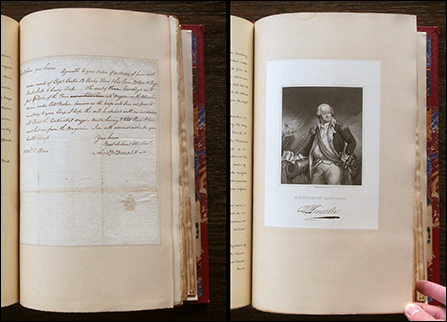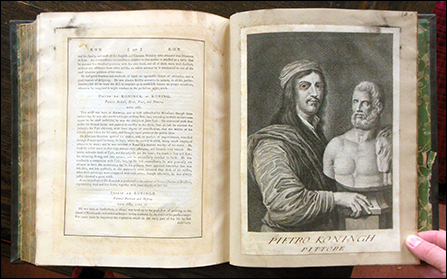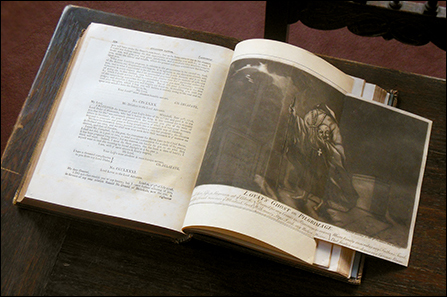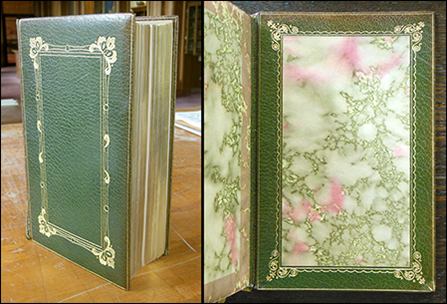Extra-Illustration: Art or Insult?
For most of us, a few penciled notes and perhaps a bookplate are as much as we're ever likely to modify the books we own. But in the 18th, 19th, and early 20th centuries, some readers made a hobby out of taking ordinary books and transforming them into something extraordinary by adding images and other carefully selected materials.
It all began in 1769, when an English clergyman and print collector named James Granger published his Biographical History of England. Although the book was unillustrated, its author listed sources of engraved portraits of its subjects and encouraged readers to go out and collect them. Many did, and, in fact, had such a good time hunting down the illustrations that they started "grangerizing" (or "extra-illustrating") other books as well. This new pastime was pursued for the most part by wealthy men, who, as historian Ellen Gruber Garvey has suggested, "found in the process of recasting and personalizing books a means to reclaim the luxury and rarity of a printed form that, thanks to mechanized printing, had become commonplace."
 Facsimiles of Manuscripts in European Archives Relating to America, 1773-1783" data-title="Grangerized copy of Facsimiles of Manuscripts in European Archives Relating to America, 1773-1783" data-align="center"/>
Facsimiles of Manuscripts in European Archives Relating to America, 1773-1783" data-title="Grangerized copy of Facsimiles of Manuscripts in European Archives Relating to America, 1773-1783" data-align="center"/>
The idea is simple. A biography of Shakespeare, for example, could be extra-illustrated by adding portraits of the bard and other historical figures, a map of his birthplace, engravings of characters from his plays, and original letters written by famous actors, plus things like playbills, newspaper clippings, watercolors — basically anything that could be bound into a book. The sky was the limit. No two extra-illustrated books are alike, each one being the product of an individual collector's skill and personal taste. (The American book collector Robert Hoe grangerized thirty copies of the same edition of Izaak Walton's The Compleat Angler just to see how much variation he could achieve.)
Because their makers had no reservations about cutting illustrations out of other books to illustrate their own, grangerized books have always had a bad reputation. In The Care and Feeding of Books Old and New (2002), grangerizing is defined as "The art, or insult, of adding illustrations to a book, often with artwork removed from other books." A "Grangerite" was, in one nineteenth-century critic's opinion, "a sort of literary Attila the Hun or Genghis Khan, who has spread terror and ruin around him."
Some grangerized books, nevertheless, are now valuable tools for research and teaching. The LSU Libraries' Rare Book Collection contains several examples of such books. The largest is Matthew Pilkington's The Gentleman's and Connoisseur's Dictionary of Painters (1798). Originally published in 840 pages, LSU's copy has been expanded to twenty volumes, comprising hundreds of rare prints related to the artists mentioned. For anyone studying the history of illustration, the set is a treasure trove of material.
 Dictionary of Painters" data-title="Pilkington's Dictionary of Painters" data-align="center"/>
Dictionary of Painters" data-title="Pilkington's Dictionary of Painters" data-align="center"/>
Another good example of extra-illustration is A Memoir of George Cruikshank, Artist and Humourist (1878) by Walter Hamilton. Its pages have been inlayed into larger sheets of paper and bound together with 116 prints by Cruikshank and his contemporaries. Some are now quite hard to find on their own, such as James Gillray's famous caricature of the Prince of Wales, titled "A Voluptuary under the Horrors of Digestion."
James Gillray print in
Some grangerized books were designed as pantheons to a nation's heros. The original owner of LSU's copy of B. F. Stevens's Facsimiles of Manuscripts in European Archives Relating to America, 1773-1783, published in 1895, not only tipped in portraits of figures from the Revolutionary War, but also a few original letters, including one to General Benjamin Lincoln, George Washington's second-in-command at the Battle of Yorktown who accepted the British surrender when Lord Cornwallis snubbed Washington by sendng his own second-in-command, General Charles O'Hara.
 Culloden Papers)" data-title=""Lovat's Ghost on Pilgrimage" (Culloden Papers)"/>
Culloden Papers)" data-title=""Lovat's Ghost on Pilgrimage" (Culloden Papers)"/>
Virtually any book could be extra-illustrated. LSU's copy of Culloden Papers, a collection of correspondence relating to Bonnie Prince Charlie's failed attempt to restore his family to the British throne in 1745-46, was grangerized by John Rushout, Lord Northwick (1770-1859). A fellow of the Society of Antiquaries, Northwick was a well-known art collector and connoisseur whose interests extended to everyday art as well as the Old Masters.
Extra-illustrated books usually had to be rebound to accommodate the additional material. Some collectors were so proud of their work that they commissioned deluxe bindings like the one seen on this copy of A New History of the English Stage.
 New History of the English Stage" data-title="New History of the English Stage" data-align="center"/>
New History of the English Stage" data-title="New History of the English Stage" data-align="center"/>
As valuable as digital surrogates are, it is important to remember that individual copies of books sometimes contain unique information that can inform our understanding of how readers in the past interacted with texts. Extra-illustration is a colorful example of how people did more with books than just read them — in some cases, they repurposed them to showcase their own taste and talent as collectors.
— Michael Taylor
